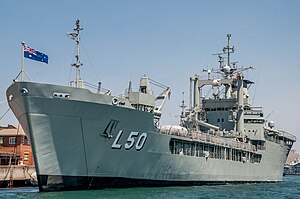HMAS Tobruk (L 50)

HMAS Tobruk at Fleet Base East in 2013
|
|
| History | |
|---|---|
|
|
|
| Namesake: | The Siege of Tobruk |
| Ordered: | 3 November 1977 (construction contract signed) |
| Builder: | Carrington Slipways, Tomago |
| Cost: | $59 million |
| Laid down: | 7 February 1978 |
| Launched: | 1 March 1980 |
| Commissioned: | 23 April 1981 |
| Decommissioned: | 31 July 2015 |
| Motto: | "Faithful and Strong" |
| Honours and awards: |
|
| Status: | Decommissioned, awaiting disposal |
| Badge: |  |
| General characteristics | |
| Class and type: | Modified Round Table-class Landing Ship Heavy |
| Displacement: |
|
| Length: | 127 m (417 ft) |
| Beam: | 18.3 m (60 ft) |
| Draught: | 4.9 m (16 ft) |
| Propulsion: | 2 × Mirrlees Blackstone KDMR8 diesel engines, 9,600 horsepower (7,200 kW), 2 shafts |
| Speed: | 18 knots (33 km/h; 21 mph) |
| Range: | 8,000 nautical miles (15,000 km; 9,200 mi) at 15 knots (28 km/h; 17 mph) |
| Boats & landing craft carried: |
2 × LCM-8, 2 × LCVP, 2 x NLE pontoons |
| Capacity: |
|
| Complement: | 148, including 13 officers (as of 2012) |
| Sensors and processing systems: |
|
| Armament: |
|
| Aviation facilities: |
|
HMAS Tobruk (L 50) was a Landing Ship Heavy (LSH) of the Royal Australian Navy (RAN), based on the design of the Round Table-class of the British Royal Fleet Auxiliary. Planning for the ship began in the 1970s to provide the Australian Army with a permanent sealift capability. She was laid down by Carrington Slipways in 1979, launched in 1980, and commissioned in 1981. She was a multi-purpose, roll-on/roll-off heavy lift ship capable of transporting soldiers, APCs, and tanks, and delivering them to shore via landing craft or directly by beaching.
The ship experienced problems during her early career with her engines (which differed from the British base design) and sewerage system (leading to the death of a cadet in 1981). During the 1980s, the ship delivered supplies to the Multinational Force and Observers on the Sinai Peninsula, assisted in the withdrawal from RAAF Base Butterworth, provided support and accommodation for delegates to the South Pacific Forum, and was part of the Australian response to the 1987 Fijian coups d'état. In the early 1990s, Tobruk was part of ceremonies marking the 75th anniversary of the landing at Anzac Cove, then after a refit, participated in peacekeeping efforts in Somalia.
Plans to replace Tobruk with one of the Kanimbla-class ships began in 1993. She was offered for sale to the Royal New Zealand Navy, who refused because of the ship's manpower requirements. Delays in converting the Kanimbla's for service meant Tobruk continued with normal operations during the 1990s. Attempts to sell the ship to the British and the Portuguese did not succeed, and in 1997 the decision was made to keep Tobruk, as the Kanimbla's could not completely replace the heavy lift capability provided. During this period, Tobruk was deployed to Bougainville on several occasions as peacekeeping operations during the Bougainville Civil War. At the end of the decade, Tobruk operated as part of the INTERFET peacekeeping operation in East Timor.
...
Wikipedia
